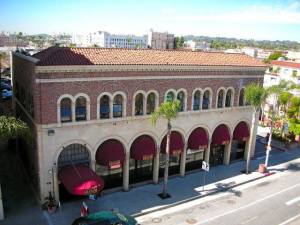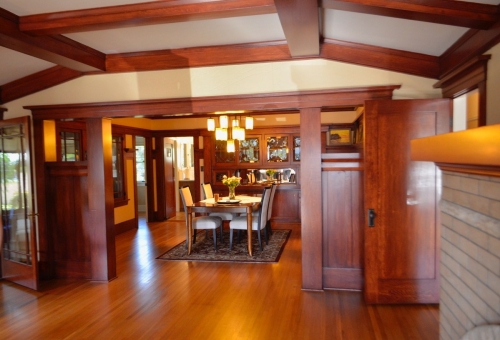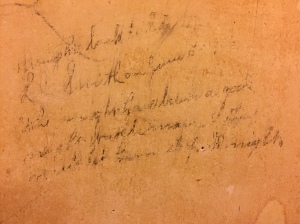
This year we are focusing on 1920s Alhambra. In this issue, we shine the spotlight on three 1920s-era buildings that are still standing in Alhambra and retain many of their defining characteristics, almost a century after they were built.
Architecturally, the 1920s introduced Art Deco, Neo-Gothic, and Beaux-Arts and many other styles of architecture to the world. It was no different in Southern California. Here in Alhambra, the Roaring Twenties was a time of tremendous growth and change as our young city welcomed a huge influx of new residents and businesses; a decade in which the local population tripled in size. It was the Jazz Age, when “Anything goes!” was the mood and everything seemed possible. Construction exploded and Alhambra saw the design of buildings that ranged from a Carnegie-funded Greek Revival-styled library to an Egyptian-themed movie theater. Sadly, many of these 1920s-era buildings have either been razed or altered beyond recognition.
Despite significant losses through the decades, Alhambra still has a number of outstanding examples of 1920s-era architecture. These buildings should be preserved, protected and celebrated. The Granada, formerly the LA Gas and Electric Corporation headquarters; the Carmelite Monastery on Alhambra Road; and The Alhambra, formerly the C F Braun & Co. headquarters, are shining examples of how the architecture of the 1920s touched the lives of Alhambrans a century ago and how that architecture still influences us today.
The Granada, formerly the Los Angeles Gas and Electric Corporation
 Constructed in 1929 at a cost of $160,000, the building was designed by LA Gas Company architects and engineers to evoke the period of the Italian Renaissance. Arched window and door openings predominate, with a glazed terra cotta base surmounted with varied-colored brick in harmonizing shades.
Constructed in 1929 at a cost of $160,000, the building was designed by LA Gas Company architects and engineers to evoke the period of the Italian Renaissance. Arched window and door openings predominate, with a glazed terra cotta base surmounted with varied-colored brick in harmonizing shades.
On September 7, 1929 the company held an “open house” at its handsome new office building. The public was invited to visit and to view the beautiful new offices. Music was furnished for the occasion by the company’s own orchestra, comprised entirely of Gas Company employees. Refreshments were served, and Manager Roy C. Gardner was on hand to greet the public as host of the gala event.
 Newspapers of the day raved about the impressive design and architecture of the building. The first floor contained the main lobby and corporate business offices, manager’s office, investigation room, vault, and distribution department offices.
Newspapers of the day raved about the impressive design and architecture of the building. The first floor contained the main lobby and corporate business offices, manager’s office, investigation room, vault, and distribution department offices.
Of beam and girder design, the interior featured floral decorations in pastel shades ornamenting the soffits and molds of the beams. In the northeast corner of the lobby was an enormous fireplace with a mantle of onyx inserts. The frontage on 1st Street was divided into large display windows, which were flood-lighted for the display of various household gas appliances. The main public stairs leading to the mezzanine floor featured a balustrade of ornamental ironwork. A mezzanine bordered the south and west walls and served as the display and demonstration area for the new gas- and electric-powered household appliances. The woodwork and doors on the first and mezzanine floors were of mahogany, as was the main public stairway leading to the second floor.
At one end of the lobby, a raised platform showcased the installed, fully equipped model tiled kitchen whose purpose was to introduce the public to the uses and benefits of natural gas, “The Modern Fuel.” The demonstration kitchen at the Los Angeles Gas and Electric Corporation was in frequent use as the venue for cooking classes and “household expositions” conducted by Florence Austin Chase, a nationally-known authority on home economics who also wrote a “women’s column” in the Alhambra Post-Advocate.
The Gas Company maintained offices at this location until 1965 when the building was sold to the West San Gabriel Valley Chapter of the American Red Cross. Today it is The Granada, a dance studio, nightclub, and event facility.
The Carmelite Monastery

The Carmel of St. Teresa in Alhambra was established in 1913, when five Carmelite Sisters left St. Louis, Missouri to establish a cloistered monastery in the Los Angeles area. Led by their Prioress, Mother Baptista, they lived in rented houses for 10 years until the present monastery could be built in Alhambra—the first one of their order in California. The cornerstone for this building was laid in June of 1922, with members of all Catholic orders in the Los Angeles area present at the ceremony.
A dignified Mediterranean Renaissance Revival building clad in red brick and capped by gabled roofs of red clay tile, the residence and sanctuary reflect their inspiration—cloistered European convents of the 16th and 17th Centuries. An outstanding example of  this type and style of architecture, the convent was described in the Pasadena Post upon its opening on June 24, 1923 as “one of the finest in the United States”. A classically articulated portal of pre-cast concrete defines the monastery’s entrance. The first floor of the convent is defined by loggias at the south and west elevations, which overlook a broad expanse of lawn and garden.
this type and style of architecture, the convent was described in the Pasadena Post upon its opening on June 24, 1923 as “one of the finest in the United States”. A classically articulated portal of pre-cast concrete defines the monastery’s entrance. The first floor of the convent is defined by loggias at the south and west elevations, which overlook a broad expanse of lawn and garden.
The convent’s sanctuary faces Alhambra Road. Reached by two flights of shallow steps, the entry is framed by columns that are surmounted by a classical entablature, consisting of an elaborately molded architrave and frieze and a broken scroll pediment. The name of the convent is chiseled into the frieze. Centered above the entrance, a deeply inset circular window is adorned by a quatrefoil reveal of cast stone. This site, at the corner of Monterey Street and Alhambra Road, was selected for the convent because of its particular beauty. Originally an orange grove, the site’s location provided an unrestricted view of the San Gabriel Mountains to the east, with snow-capped ranges just beyond.
 Alhambra’s Carmelite Monastery was designed by one of Southern California’s most prominent architects. John C. Austin was born in England in 1870, immigrating to California in the 1890’s. He established an architectural practice in Los Angeles in 1895. Austin was very active in local civic affairs, serving as President of the Los Angeles Chamber of Commerce, the Southern California Historical Society, and the Jonathan Club, as well as the California Board of Architectural Examiners. He designed some of the most famous and easily-recognized landmark buildings in the Los Angeles area, many of which are listed on the National Register of Historic Places. Among these distinguished buildings are the Los Angeles City Hall, the Shrine Auditorium, and the Griffith Observatory.
Alhambra’s Carmelite Monastery was designed by one of Southern California’s most prominent architects. John C. Austin was born in England in 1870, immigrating to California in the 1890’s. He established an architectural practice in Los Angeles in 1895. Austin was very active in local civic affairs, serving as President of the Los Angeles Chamber of Commerce, the Southern California Historical Society, and the Jonathan Club, as well as the California Board of Architectural Examiners. He designed some of the most famous and easily-recognized landmark buildings in the Los Angeles area, many of which are listed on the National Register of Historic Places. Among these distinguished buildings are the Los Angeles City Hall, the Shrine Auditorium, and the Griffith Observatory.
The Alhambra, formerly the C F Braun & Co. Headquarters

Carl Franklin Braun, the founder C F Braun & Co. was a man who was always looking forward. Born in Oakland, CA in 1884, the son of California pioneers of Swedish and Danish descent, Carl Braun grew to be a man of many talents — an engineer, a salesman, a bibliophile, a teacher and an author. He studied mechanical engineering at Stanford University and started C F Braun & Co. in 1909 with a few associates and $500 capital. His firm would go on to become a 20th century leader in petro-chemical engineering, making substantial contributions to the World War II effort by working around the clock to build plants that produced aviation-grade fuel and synthetic rubber.
 C F Braun & Co. moved its international headquarters to Alhambra from San Francisco in 1921. The complex included towering brick walls, 22 buildings and a landscaped plaza on 36 acres. The primary building material for this “modern office complex” was brick – all purchased from the same San Francisco manufacturer. Braun was a practical man, an engineer, who didn’t hesitate to move or modify buildings — or to build new ones — according to the nature of the work in which the company was involved and the functional needs of its various manufacturing projects. The significance — and the beauty — of this campus is that, through dozens of modifications and 92 years of operation, purposeful attention to architectural character and detail has preserved the integrated whole.
C F Braun & Co. moved its international headquarters to Alhambra from San Francisco in 1921. The complex included towering brick walls, 22 buildings and a landscaped plaza on 36 acres. The primary building material for this “modern office complex” was brick – all purchased from the same San Francisco manufacturer. Braun was a practical man, an engineer, who didn’t hesitate to move or modify buildings — or to build new ones — according to the nature of the work in which the company was involved and the functional needs of its various manufacturing projects. The significance — and the beauty — of this campus is that, through dozens of modifications and 92 years of operation, purposeful attention to architectural character and detail has preserved the integrated whole.
 C F Braun & Co.’s interior offices featured wood paneling and were “pleasingly appointed and well-lighted” as described in a promotional brochure. It had every amenity needed for a modern manufacturing plant including a state-of-the-art engineering library, woman’s lounge, men’s locker room, a restaurant and a medical office staffed by an on-site physician. Mr. Braun’s goal was to “provide comfortable and pleasant surroundings for its workers, of every class, that they may have pleasure in their work and pride in their plant and product.” He took a great deal of pride in the “modern workplace” that he created.
C F Braun & Co.’s interior offices featured wood paneling and were “pleasingly appointed and well-lighted” as described in a promotional brochure. It had every amenity needed for a modern manufacturing plant including a state-of-the-art engineering library, woman’s lounge, men’s locker room, a restaurant and a medical office staffed by an on-site physician. Mr. Braun’s goal was to “provide comfortable and pleasant surroundings for its workers, of every class, that they may have pleasure in their work and pride in their plant and product.” He took a great deal of pride in the “modern workplace” that he created.
The Granada, the Carmelite Monastery and The Alhambra are an integral part of Alhambra’s story. They inform Alhambrans about what life was like and how people lived and worked during the 1920s – a time of intense growth in our city. They offer a visual history. Their designs were thoughtful. Their materials and workmanship reveal the artistry, industry and aesthetic of the people who built them and the time in which they were built. When we allow historic buildings to be demolished, we sacrifice those touchstones that, by revealing our past, can help to inform decisions about our future.
Alhambra Preservation Group continues its work to protect and preserve Alhambra’s local historic and architectural landmarks and to celebrate their unique and irreplaceable contributions to our city’s community and culture.
A special thank you to Chris Olson, former president and board of member of Alhambra Preservation Group, for her assistance in writing this article.
Read Full Post »
 We need your help to save one of Alhambra’s few remaining Bungalow Courts and a Craftsman home.
We need your help to save one of Alhambra’s few remaining Bungalow Courts and a Craftsman home.
 Constructed in 1929 at a cost of $160,000, the building was designed by LA Gas Company architects and engineers to evoke the period of the Italian Renaissance. Arched window and door openings predominate, with a glazed terra cotta base surmounted with varied-colored brick in harmonizing shades.
Constructed in 1929 at a cost of $160,000, the building was designed by LA Gas Company architects and engineers to evoke the period of the Italian Renaissance. Arched window and door openings predominate, with a glazed terra cotta base surmounted with varied-colored brick in harmonizing shades. Newspapers of the day raved about the impressive design and architecture of the building. The first floor contained the main lobby and corporate business offices, manager’s office, investigation room, vault, and distribution department offices.
Newspapers of the day raved about the impressive design and architecture of the building. The first floor contained the main lobby and corporate business offices, manager’s office, investigation room, vault, and distribution department offices.
 this type and style of architecture, the convent was described in the Pasadena Post upon its opening on June 24, 1923 as “one of the finest in the United States”. A classically articulated portal of pre-cast concrete defines the monastery’s entrance. The first floor of the convent is defined by loggias at the south and west elevations, which overlook a broad expanse of lawn and garden.
this type and style of architecture, the convent was described in the Pasadena Post upon its opening on June 24, 1923 as “one of the finest in the United States”. A classically articulated portal of pre-cast concrete defines the monastery’s entrance. The first floor of the convent is defined by loggias at the south and west elevations, which overlook a broad expanse of lawn and garden. Alhambra’s Carmelite Monastery was designed by one of Southern California’s most prominent architects. John C. Austin was born in England in 1870, immigrating to California in the 1890’s. He established an architectural practice in Los Angeles in 1895. Austin was very active in local civic affairs, serving as President of the Los Angeles Chamber of Commerce, the Southern California Historical Society, and the Jonathan Club, as well as the California Board of Architectural Examiners. He designed some of the most famous and easily-recognized landmark buildings in the Los Angeles area, many of which are listed on the National Register of Historic Places. Among these distinguished buildings are the Los Angeles City Hall, the Shrine Auditorium, and the Griffith Observatory.
Alhambra’s Carmelite Monastery was designed by one of Southern California’s most prominent architects. John C. Austin was born in England in 1870, immigrating to California in the 1890’s. He established an architectural practice in Los Angeles in 1895. Austin was very active in local civic affairs, serving as President of the Los Angeles Chamber of Commerce, the Southern California Historical Society, and the Jonathan Club, as well as the California Board of Architectural Examiners. He designed some of the most famous and easily-recognized landmark buildings in the Los Angeles area, many of which are listed on the National Register of Historic Places. Among these distinguished buildings are the Los Angeles City Hall, the Shrine Auditorium, and the Griffith Observatory.
 C F Braun & Co. moved its international headquarters to Alhambra from San Francisco in 1921. The complex included towering brick walls, 22 buildings and a landscaped plaza on 36 acres. The primary building material for this “modern office complex” was brick – all purchased from the same San Francisco manufacturer. Braun was a practical man, an engineer, who didn’t hesitate to move or modify buildings — or to build new ones — according to the nature of the work in which the company was involved and the functional needs of its various manufacturing projects. The significance — and the beauty — of this campus is that, through dozens of modifications and 92 years of operation, purposeful attention to architectural character and detail has preserved the integrated whole.
C F Braun & Co. moved its international headquarters to Alhambra from San Francisco in 1921. The complex included towering brick walls, 22 buildings and a landscaped plaza on 36 acres. The primary building material for this “modern office complex” was brick – all purchased from the same San Francisco manufacturer. Braun was a practical man, an engineer, who didn’t hesitate to move or modify buildings — or to build new ones — according to the nature of the work in which the company was involved and the functional needs of its various manufacturing projects. The significance — and the beauty — of this campus is that, through dozens of modifications and 92 years of operation, purposeful attention to architectural character and detail has preserved the integrated whole. C F Braun & Co.’s interior offices featured wood paneling and were “pleasingly appointed and well-lighted” as described in a promotional brochure. It had every amenity needed for a modern manufacturing plant including a state-of-the-art engineering library, woman’s lounge, men’s locker room, a restaurant and a medical office staffed by an on-site physician. Mr. Braun’s goal was to “provide comfortable and pleasant surroundings for its workers, of every class, that they may have pleasure in their work and pride in their plant and product.” He took a great deal of pride in the “modern workplace” that he created.
C F Braun & Co.’s interior offices featured wood paneling and were “pleasingly appointed and well-lighted” as described in a promotional brochure. It had every amenity needed for a modern manufacturing plant including a state-of-the-art engineering library, woman’s lounge, men’s locker room, a restaurant and a medical office staffed by an on-site physician. Mr. Braun’s goal was to “provide comfortable and pleasant surroundings for its workers, of every class, that they may have pleasure in their work and pride in their plant and product.” He took a great deal of pride in the “modern workplace” that he created. With COVID-19 turning our world upside down, we’re all looking for ways to occupy our time while we stay safer at home. Why not take advantage of all the free virtual tours available online?
With COVID-19 turning our world upside down, we’re all looking for ways to occupy our time while we stay safer at home. Why not take advantage of all the free virtual tours available online?  by Oscar Amaro, Founder and President, Alhambra Preservation Group
by Oscar Amaro, Founder and President, Alhambra Preservation Group

 Kids and Candidates, a community engagement forum, will be held on Thursday, October 11, 2018 from 6-8:30 p.m. at Alhambra High School, located at 101 South 2nd Street in Alhambra. The event is free to the public. Spanish and Mandarin translators will be available at the event. For more information, visit the event’s
Kids and Candidates, a community engagement forum, will be held on Thursday, October 11, 2018 from 6-8:30 p.m. at Alhambra High School, located at 101 South 2nd Street in Alhambra. The event is free to the public. Spanish and Mandarin translators will be available at the event. For more information, visit the event’s  “We wanted to bring the ‘Wow!’ factor back,” explained Regina Cipriani, a lifelong Alhambra resident, explained. “Now, when you open the door, you see all the wood detailing that make Craftsman homes so stunning.
“We wanted to bring the ‘Wow!’ factor back,” explained Regina Cipriani, a lifelong Alhambra resident, explained. “Now, when you open the door, you see all the wood detailing that make Craftsman homes so stunning.
 The home also revealed surprises. A now mostly illegible message written in pencil on the plaster in the rear bedroom dated August 1912 with the name “Schmidt” and “good night,” was found hidden under wallpaper.
The home also revealed surprises. A now mostly illegible message written in pencil on the plaster in the rear bedroom dated August 1912 with the name “Schmidt” and “good night,” was found hidden under wallpaper. An original Craftsman-style light fixture pendant was discovered in the basement. Probably one of the 10 fixtures that originally hung from the living room beams, and a match to the existing fixture in the library. It was rewired and now hangs in the breakfast room. “You think you know a house. But with these beautiful old Craftsman homes, there is still a lot to discover.”
An original Craftsman-style light fixture pendant was discovered in the basement. Probably one of the 10 fixtures that originally hung from the living room beams, and a match to the existing fixture in the library. It was rewired and now hangs in the breakfast room. “You think you know a house. But with these beautiful old Craftsman homes, there is still a lot to discover.”
